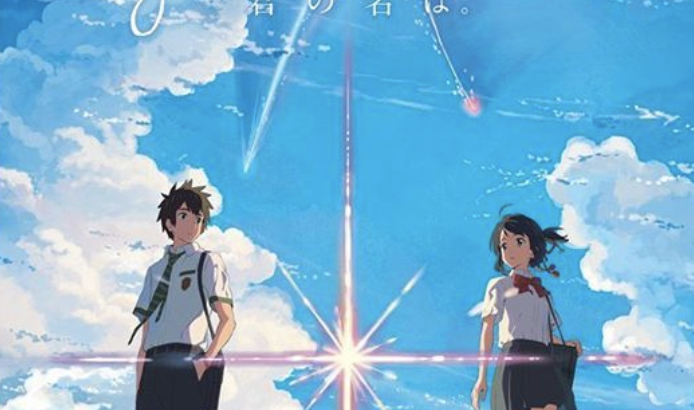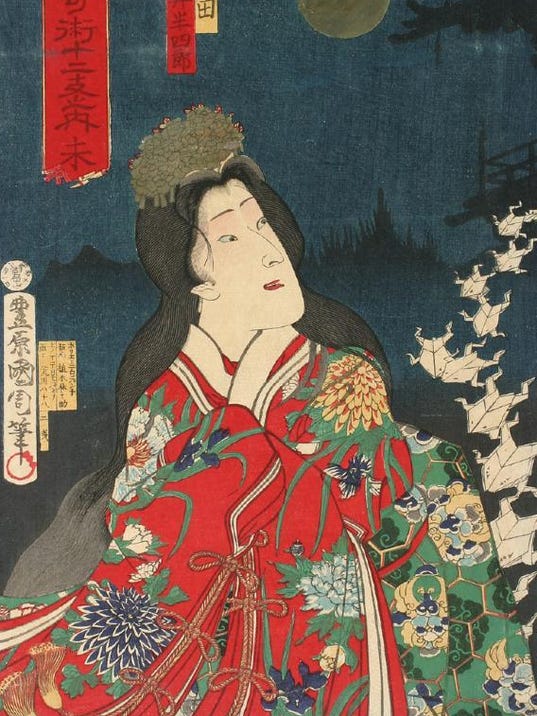Sitting on a 2’x2’ cushion on stage, in front of a large audience, telling a funny story — that is the 400-year-old art of Japanese storytelling, or rakugo.
 Having some prior knowledge of rakugo, the moment I heard about a live performance in Ann Arbor — free of charge — I knew. I was there. Doors opened at 6:30PM in U-M’s Modern Language Building Auditorium 4. The performance was planned for 7PM sharp. Although my friend and I arrived on time, we were greeted by a full house. In fact, it was so crowded, people were standing against the walls. We were handed a very nice program that was half in Japanese and half in English, detailing the night’s schedule.
Having some prior knowledge of rakugo, the moment I heard about a live performance in Ann Arbor — free of charge — I knew. I was there. Doors opened at 6:30PM in U-M’s Modern Language Building Auditorium 4. The performance was planned for 7PM sharp. Although my friend and I arrived on time, we were greeted by a full house. In fact, it was so crowded, people were standing against the walls. We were handed a very nice program that was half in Japanese and half in English, detailing the night’s schedule.
Organized by the U-M Japanese Language Program and Center for Japanese Studies, I saw the faculty dressed in kimonos. In case you don’t know what kimonos are, they’re long, loose robes with wide sleeves and tied with a sash, originally worn as a formal garment in Japan.
Seeing beautiful and intricate patterns, colorful fabric, wooden sandals, I could feel my heart punch a hole through my chest. This was the real dea l.
l.
Well, thanks to my punctuality, my friend and I found front row seats…on the floor. The faculty handed us Japanese newspapers to sit on and apologized that there were no seats left. It was really no trouble, though. Sitting on the floor was a pain in the butt, but the show was free, and we had a great view of the stage. It was red, with a lush purple 2’x2’ cushion sitting on top of it. A paper lantern stood on each side.
The show began by first teaching the audience a little bit about rakugo and giving a short demonstration as to how a typical performance is done.

Rakugo is a traditional comedic performance that definitely throws anyone for a loop the first time around, but it’s actually pretty easy to understand. Long story short, the performer sits on the cushion on stage and tells a story. They do this by enacting every character in the story, and using their only two props: a paper fan and a tenugui (Japanese towel). They may stand up on their knees but never on their feet, so the performance never leaves the cushion.
Because the performer has so much to act out, their creativity and skill shine through the performance. They can use the fan as a pair of chopsticks or as a pen, they can use the towel as a letter or a book! The performance really delivers the story.
After the crash course on rakugo, the performances came next. Because the show was organized by the university’s Japanese Language Program, students studying Japanese were able to participate in this unique art of storytelling. One by one, short stories a couple minutes long were told by each student.
 One of the students told a story about a little girl greeting her father who had come home from a seaward trip. The girl urged to see his photos of the ocean, gushing over the fish swimming underwater. In one photo, the girl found a sea creature that was uglier than the rest and, disgusted, she asked her father what it was. Then the father scolded her, because it was not a fish — it was her mother!
One of the students told a story about a little girl greeting her father who had come home from a seaward trip. The girl urged to see his photos of the ocean, gushing over the fish swimming underwater. In one photo, the girl found a sea creature that was uglier than the rest and, disgusted, she asked her father what it was. Then the father scolded her, because it was not a fish — it was her mother!
In rakugo, the story typically leads up to a hilarious punch line at the very end. And honestly, they were really funny! I was cracking up on the floor, trying to hold in my hideous snorts.
 After the students were the two Japanese rakugo performers, who had flown to the United States all the way from Japan as cultural envoys. Rakugo professionals.
After the students were the two Japanese rakugo performers, who had flown to the United States all the way from Japan as cultural envoys. Rakugo professionals.
Yanagiya Sankyo (柳家さん喬) and Yanagiya Kyonosuke (柳家喬之助) are two widely famous rakugo performers in Japan, and tickets to see their shows are priced usually over $30 per person! It was the biggest honor to be able to see their performances for free. I was just happy to be there. Even if I was sitting at eye level with people’s feet.
Unfortunately, photography was prohibited for the two famous rakugo performers. But I promise you, they were amazing. Sitting up there with their commanding presence, their expressions and voices varying with every character — it was truly an art. Just by a small turn of their torso, they suddenly became a different person! Their performances were definitely the highlight of the night.
Yanagiya Kyonosuke (柳家喬之助) performed first with the story Hatsu Tenjin (初天神, “First Tenjin Festival”), which was summarized in the program: “A precocious boy named Kinbou convinces his father to take him to the festival at the Tenjin shrine, on the condition that he won’t bother his father to buy him anything. At the festival, of course, Kinbou can’t help asking for everything he sees, causing problems for his father.”
It was a hilarious performance, and the room roared with laughter as Yanagiya Kyonosuke pouted and wailed as the child. Kinbou was one spunky child, and I loved every second of his character on stage. It was an incredible performance by an incredible performer!
The last performance carries the most prestige in a rakugo show. After a brief intermission, Yanagiya Sankyo (柳家さん喬) delivered the last performance, telling the story of Shinigami (死神, “The God of Death”). In the program, it was summarized: “The God of Death tells a man who has decided that he wants to die that it’s not his time yet and teaches him a way to make a living as a doctor. He grants the man the ability to see the God of Death and teaches him a spell. If the God of Death is sitting by the patient’s feet, then the patient will recover. He simply has to recite the spell and the sick person will get well. If the God of Death is at the patient’s head, there’s nothing that can be done for him. The man becomes very wealthy but spends lavishly on trips and ends up broke. When patients stop coming, he becomes desperate to regain his fortune. But is it possible to trick the God of Death?”
Shinigami (死神, “The God of Death”) is one of the most popular and famous rakugo stories out there, and although it’s a little on the scarier side, it has its funny moments. Shinigami was beautifully told by Yanagiya Sankyo. Everyone was plunged straight into the story as he acted out the God of Death and the cheating doctor. As the God of Death, Yanagiya Sankyo held the fan like a cane under his hands, chuckling at the man’s misfortune. I was enraptured by his performance, visualizing the elements that weren’t there. It was a wonderful story told by a wonderful performer to end a wonderful night.
If you ever catch the word rakugo — keep your ears peeled. A story will be told!














